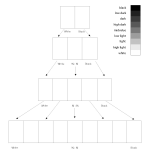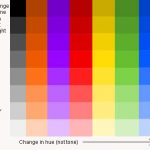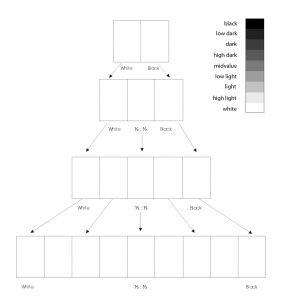October 25, 2018
What’s DUE?
- Field Trip Reflection:
- Create a post on the Class Blog about the New Lab field trip
- Post Title: Field Trip to New Lab
- Post Content: Choose one new thing that you learned on this field trip. Note the details. Is there anything about this experience that surprised you or made you think or feel differently? Include any images, with caption.
- Post Category: Field Trip
- Comment: On at lease 1 other student’s Field Trip post.
- Project #2 is due!
- Add your Phase 3 post to the Class Site. We will have critique on Thursday to review your animation work.
Materials needed:
- Sketchbook, 9×12″ Bristol, pencils, eraser, knife/scissors, ruler/T-square, drafting tape.
Peer Critique
- Review the guidelines and vocabulary for Project #2.
- Review all Animated Mashups from the class blog.
- Choose 2 posts with the least number of comments and provide feedback to each.
- These should be full, thoughtful critiques of your peer’s good effort. Be thorough and helpful. If you have ideas about how the work can be improved, share them!
Discussion
The Elements: basic components used as part of any composition, independent of the medium.
- Value: Signifies the relative differences of light and dark
- Achromatic: Value with the absence of hue (color) and saturation (intensity).
- Chromatic: Value demonstrated by a given hue.
- Grayscale: The full range of values simplified into a graduated scale.
- Low-Key: When the values of an image are predominately dark
- High-Key: When the values of an image are predominately light
- Narrow Range: When the values congregate around the dark, middle, or light part of the grayscale.
- Broad Range: When the values are spread over the dark, middle, or light part of the grayscale.
- Shadow: Dark area of an object as a result of a disruption of the light source.
- Highlight: Portion of an object that receives the greatest amount of direct light
- Chiaroscuro/Tenebrism: Forceful use of contrasting lights and darks, creating a dramatic mood.
The Principles: basic assumptions that guide the design practice.
- Emphasis: The special attention or importance given to one part of a composition. Emphasis can be achieved through placement, contrast, size, etc.
- Dominance/Hierarchy: The expression of visual and conceptual order that communicates degrees of importance of the various parts of a composition. This can also be achieved through placement, contrast, size, etc.
- Focal Point: The elements or objects on which the viewer’s attention is focused.
- Contrast: Occurs when elements are unrelated or dissimilar in value, size, shape, etc. Increasing contrasts can create dominance.
References:
- Narrow- High Key
- Narrow- High Key
- Narrow- High Key
- Narrow- Low Key
- Narrow- Low Key
- Narrow- Low Key
- Achromatic Value Scale
- Chromatic Value Scale
- High Key
- Broad
- Broad
- Jacob Lawrence
- Jacob Lawrence
- Chiaroscuro
LAB
Value Range Research: HANDS
- high-key, narrow value range
- broad value range
- low-key, narrow value range
- Using your camera or camera phone*, compose 3 photographs of your hands with the following qualities:
- (1) predominately within the high-key / light value range
- (1) predominately within the low-key / dark value range
- (1) broad value range – spread over the dark, middle, or light parts of the grayscale.
- If you have the ability to shoot in grayscale or with a silvertone or noir filter, please do.
- Designate a new section of your sketchbook and write ‘Value-Added Portraits’.
- Compose a minimum 2-paragraph description, with specific references to the images, indicating how the key sets the mood of the composition. Also notice and report how the forms in the composition create highlight and shadow relationships; some may be abrupt, others may have a gradation of value from light to dark. How does this contribute expressive quality (mystery, drama, success, joy, etc) of the compositions?
* If you don’t have a camera, please partner with another student who does.
Value Scale
Complete the Achromatic Value Scale using pencils
- On the handout provided, create 4 scales starting with 2 steps and ending with 9 steps ranging from black to white in even, progressive increments.
- Your 9-step value scale should have black, low dark, dark, high dark, mid-value, low light, high light, and white.
Homework
Complete the following before next class:
VALUE RANGE RESEARCH:
- Create a new blog post called Value-Added Portraits: Phase 1.
- Refine your writing and add it to your post.
- Add a gallery with your 3 images. Don’t forget to caption them High Key – Narrow Value Range, Low Key- Narrow Value Range, and Broad Value Range
- Include the hours that you worked on this part of the project.
- Comment on at least 1 other student’s posts.
PROJECT #2
- Finish Phase 4: Deliver for Project #2. If you don’t post Phase 4: Deliver, you will not receive a grade for the project.
Materials needed:
- Download and PRINTOUT 5 laser prints of your portrait ((DOWNLOAD HERE))
- IMPORTANT NOTE: If you missed this class and didn’t get your photograph taken, contact the professor BEFORE THE NEXT CLASS.
- Bring: Sketchbook, 9×12″ Bristol, pencils, eraser, knife/scissors, ruler/T-square, drafting tape.




















